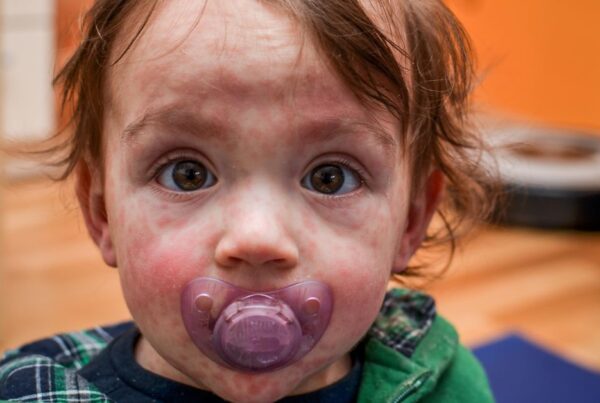Many parents have asked, “What are the bumps on the backs of my child’s arms and how do I make them go away?” This rough, bumpy skin is called keratosis pilaris. It affects 50-80% of adolescents, 40% of adults, and is common in younger children as well.
It isn’t physically harmful, but it can cause emotional distress, social problems, and body image issues.
Keratosis pilaris often responds well to integrative treatment which addresses both the health of the skin and the internal state of the body.
What is Keratosis Pilaris?
Keratosis pilaris is a common condition that is characterized by tiny bumps and rough dry patches on the skin. It can occur anywhere that hair grows, but is most commonly found on the upper arms. It is also common on the thighs, buttocks, and cheeks. Bumps are usually white on light skin and grey on dark skin. Bumps are caused by dead skin cells which plug hair follicles.
As the bumps heal, they can cause red/purple discoloration on light skin and brown/black discoloration on dark skin. The bumps aren’t usually itchy or painful, but can be if the skin gets very dry.
Keratosis pilaris isn’t harmful or contagious.
What Causes Keratosis Pilaris?
The causes of keratosis pilaris aren’t well known. However, there is a genetic component.
Clinically, integrative doctors have observed that keratosis pilaris is often associated with gluten intolerance, and nutrient deficiencies. In my practice, I have also heard from many parents that it begins after vaccination.
The most important nutrient deficiency associated with keratosis pilaris is vitamin A. Vitamin C and essential fatty acid deficiency may also be important.
Untreated gluten allergy or intolerance can lead to inflammation and deficiencies of many nutrients including vitamin A. In one study, vaccination was shown to reduce vitamin A levels. It hasn’t been further investigated to my knowledge.
For more information about how nutrients interact with vaccines, see my vaccine strategy guide.
Integrative Treatment For Keratosis Pilaris
Unlike conventional treatment which focuses only on the symptom, integrative treatment also addresses the cause. If conventional treatment alone is used, symptoms tend to return once the treatment is stopped.
Integrative treatment starts with addressing the internal environment and finishes with healing the skin.
Remove food sensitivities if present
Keratosis pilaris is a sign that food sensitivities may be present. They can be assessed through elimination diets or through other testing. Food sensitivities can be difficult to navigate so it is best to work with an integrative doctor.
Heal the gut
Once food sensitivities are removed (if present) the gut can start to heal. A healthy gut reduces the overall inflammation in the body and absorbs nutrients optimally. Healing the gut can be as simple as adding a probiotic and bone broth, or it may require more intensive treatment. An anti-inflammatory diet is often recommended as well.
Nutrient supplementation
Vitamin A supplementation is the most important consideration and I’ve seen keratosis pilaris resolve with just this one intervention. However, vitamin C, essential fatty acids, and collagen powder can also be helpful.
Dermatologic treatment of skin
Dermatologic treatment of keratosis pilaris has two components: 1) exfoliating the skin and 2) moisturizing.
Key exfoliating ingredients to look for are lactic acid, and/or urea, glycolic acid, salicylic acid. These chemical exfoliants may not be suitable for young children and may cause allergic reactions in some people. Dry brushing and/or washing with a rough washcloth or scrub may help. Consult a dermatologist for a personalized plan.
Strategies for keeping the skin moisturized and reducing overall skin irritation include choosing gentle soap and laundry detergent, having warm rather than hot showers, using a humidifier, and moisturizing after bathing.
Note: The exfoliating moisturizer I most commonly recommend is Amlactin (no affiliation).
Summary
Keratosis pilaris is the name of the condition that causes rough, dry, bumpy skin on the upper arms, legs, buttocks, and cheeks. It is also known as chicken skin rash and is caused by excess keratin which plugs hair follicles. Keratosis pilaris has a genetic component and is associated with vitamin A deficiency. Vitamin A deficiency may occur after vaccination or as a side effect of gluten or other food intolerances. Integrative treatment involves removing food sensitivities (if present), healing the gut, restoring nutrients, and treating the skin directly.
Keratosis pilaris isn’t harmful or contagious but can cause significant social-emotional distress. It is worth taking seriously and treating.
References
Agharbi F. Z. (2019). Kératose pilaire [Keratosis pilaris]. The Pan African medical journal, 33, 274.
Pennycook, K. B., & McCready , T. A. (2021). Keratosis Pilaris. In StatPearls. StatPearls Publishing.
Maghfour, J., Ly, S., Haidari, W., Taylor, S. L., & Feldman, S. R. (2020). Treatment of keratosis pilaris and its variants: a systematic review. The Journal of dermatological treatment, 1–12. Advance online publication.
Thomas, M., & Khopkar, U. S. (2012). Keratosis pilaris revisited: is it more than just a follicular keratosis?. International journal of trichology, 4(4), 255–258.
Yalçin, S. S., Yurdakök, K., Ozalp, I., & Coşkun, T. (1998). The effect of live measles vaccines on serum vitamin A levels in healthy children. Acta paediatrica Japonica : Overseas edition, 40(4), 345–349.
Roszkowska, A., Pawlicka, M., Mroczek, A., Bałabuszek, K., & Nieradko-Iwanicka, B. (2019). Non-Celiac Gluten Sensitivity: A Review. Medicina (Kaunas, Lithuania), 55(6), 222.
Alkalay M. J. (2021). Nutrition in Patients with Lactose Malabsorption, Celiac Disease, and Related Disorders. Nutrients, 14(1), 2.








